

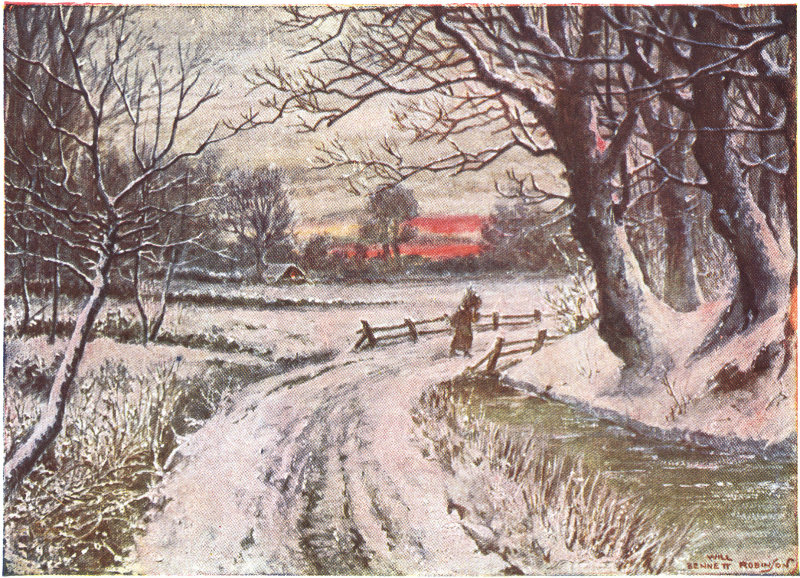
The land is at rest
BOOK II.
BY
THOMAS W. HOARE
TEACHER OF NATURE STUDY
to the Falkirk School Board and Stirlingshire County Council
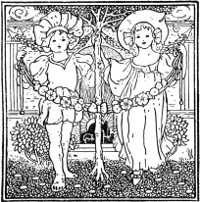
LONDON: T. C. & E. C. JACK, Ltd.
35 PATERNOSTER ROW, E.C.
AND EDINBURGH
This little book should be used as a simple guide to the practical study of Nature rather than as a mere reader.
Every lesson herein set down has, during the author’s many years’ experience in teaching Nature Study, been taught by observation and practice again and again; and each time with satisfactory result. The materials required for the lessons are within everybody’s reach.
There is nothing that appeals to the heart of the ordinary child like living things, be they animal or vegetable, and there is no branch of education at the present day that bears, in the young mind, such excellent fruit as the study of the simple, living things around us.
Your child is nothing if not curious. He wants to understand everything that lives in his bright little world.
Nature Study involves so many ingenious little deductions, that the reasoning powers are almost constantly employed, and intelligence grows proportionately. The child’s powers of observation are stimulated, and his memory is cultivated in the way most pleasing to his inquiring nature. By drawing his specimens, no matter how roughly or rapidly, his eye is trained more thoroughly than any amount of enforced copying of stiff, uninteresting models of prisms, cones, etc., ever could train it.
The love of flowers and animals is one of the most commendable traits in the disposition of the wondering child, and ought to be encouraged above all others. A few lessons on Nature Phenomena are added.
It is the author’s fondest and most sanguine hope that his little pupils may study further the great book of Nature, whose broad pages are ever open to us, and whose silent answers to our manifold questions are never very difficult to read.
T. W. H.
Uncle George had taught his little friends many things from what he called the Book of Nature, and what they had learnt made them eager to know more.
One day as Dolly, the boys, and Uncle George were in the garden they saw that a tulip, which the day before was in full bloom and strong, was now lying dead on the ground.
“Poor little tulip!” said Dolly. Both the boys were sorry too. They had watched it come through the ground like a blade of grass, open out its bud, and expand its 6 bloom. Now all was over. The little flower would no longer enjoy the bright sunshine or the rain. It would no longer send forth its rootlets in search of the food it so much liked.
“Have you ever thought, Dolly, how the tulip, and indeed all plants, take their food from the soil?” asked Uncle George.
“I know they must feed in some way,” said Dolly, “or they would not grow. But I do not know how they do it.”
“Should you like to know, Dolly?” asked Uncle George.
“Indeed I should,” said the little girl.
The boys were just as eager as Dolly to know about this, so Uncle George and the children went indoors for a lesson.
“I cannot tell you how plants take their food from the soil without first of all showing you what happens when water and soil are mixed together in a tumbler,” said Uncle George. “Tom will fetch me a tumbler, and you, Frank, bring me a little water.”
When these were brought, Uncle George put a spoonful of soil into the tumbler, and then poured some water on it.
“Stir it up, please, Dolly,” said Uncle 7 George, “and you may pretend you are going to make a pudding.”
Dolly did so.
“Now let us put it aside for a few minutes, while we place the flowers we have gathered into the vases,” said Uncle George. “Then we will look at our tumbler of muddy water.”
How pretty the flowers were made to look! How fresh they were! and how pleasant was their scent! The children hardly thought of the tumbler, but Uncle George was ready now for the lesson.
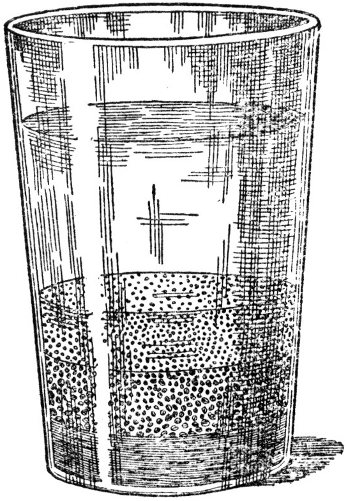
Glass of Mud and Water.
“Look! look, at the tumbler,” said he. “Do you see a change?”
“Indeed we do,” said all the children in one voice.
“The mud has sunk to the bottom of the glass,” added Tom, “and the water on the top is clear.”
Uncle George poured some of the clear water into a clean flat dish. Then he took a spirit-lamp from a little cabinet, and heated the water in the dish with it.
The children watched to see what would 8 happen. Soon a cloud was seen over the dish, and by and by all the water had gone.
“But what is that at the bottom of the dish?” asked Uncle George.
“It looks like powder,” said Frank.
“And it must have been in the water all the time,” added Tom.
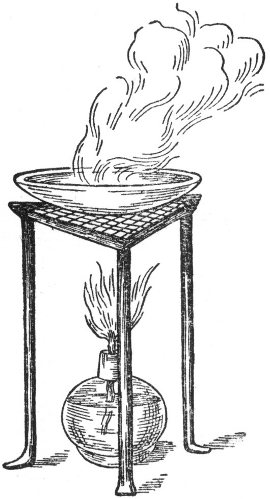
Evaporating Salt Water.
“And yet the water was clear,” said Uncle George. “Look once more.”
As he spoke, Uncle George took a glass of clean water from the tap. He put two large spoonfuls of salt in, and stirred it up.
“You see,” he said, “the salt has gone from sight. Still the water is clear. Where has it gone?”
“Into the water,” said Tom.
Uncle George put more salt in the water, and stirred it up. He kept on doing this until the water would take up no more salt, no matter how much it was stirred. This he called brine.
“Now, Frank, please go and ask mother 9 for a fresh egg,” he said, “and you, Tom, please bring me some fresh water in another glass.”
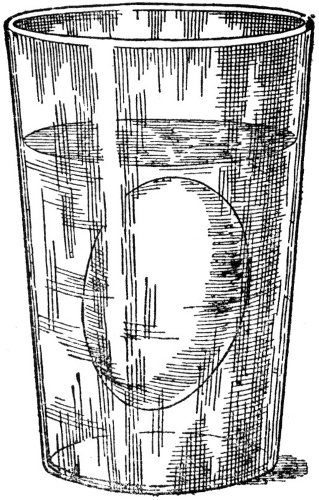
Egg floating in Salt Water.
Uncle George placed the egg in the glass in which the salt had been put, and it floated in it. He then placed the egg in the glass of fresh water, and it at once sank to the bottom.
“Can you explain this!” he said.
“The salt water is heavier and thicker than the fresh water. That is why it bears up the egg,” said Frank.
“That is very good indeed, Frank. That is just the reason. The salt water or brine is denser, or heavier, than the other.”
Uncle George next took a glass tube with a thistle-shaped bulb at the end of it. Frank kept his finger on the small end, while his uncle poured some of the brine into the bulb. He next tied a piece of bladder skin over the bulb, and placed it in a glass of fresh water, so that the salt water 10 in the tube was at the same level as the fresh water in the glass.
Then he took two small glass bottles. He filled one with fresh water and the other with brine, and tied a piece of bladder skin over the mouth of each. The one which was filled with brine he placed in a larger dish of fresh water. The other, that is the one filled with fresh water, he placed in a dish of brine.
“Now, children, we will go and have tea,” he said, “and when we come back we will see if any change has taken place.”
About an hour later Uncle George, Dolly, and the boys came back.
“Oh,” said Frank, “look, Uncle George! The water has risen up in the thistle tube.”
“Yes, how do you account for that, Frank?”
“Some of the fresh water has passed through the skin,” Frank answered.
“Now taste the water in the glass outside the skin,” said Uncle George. “It was fresh water when we put it in, wasn’t it?”
Frank did so. Tom tasted it too. Both boys declared that it was now salt.
“Where did the salt taste come from?” their uncle asked.
“It must have come through the skin,” said Tom.
“Then some of the salt water in the thistle tube has passed through the skin into the glass; and some of the fresh water in the glass has passed through the skin into the thistle tube. Can you tell me any more?”
Frank thought for a little while and then said, “Oh yes, more fresh water than salt water has passed through the skin, because the salt water is now far up the tube.”
“Quite right, my boy. Now let us look at the small bottles. The skin on the one filled with brine is swollen out like a ball, while the water in the dish tastes salt. The skin of the other is drawn far in, showing us that much of the fresh water which it contained has passed out. If you taste the water in this bottle, you will find that a very little of the brine in the dish has passed into it through the skin.
“Now what we learn from these things is really this—that when two liquids, a heavy and a light one, are separated by a thin skin, they both pass through the skin. The heavy liquid passes through slowly, and the light liquid passes through quickly.”
Uncle George then placed some small seeds on a piece of wet blotting-paper. He turned a glass tumbler upside down, and placed it over them.
“We will leave these for a few days,” he said.
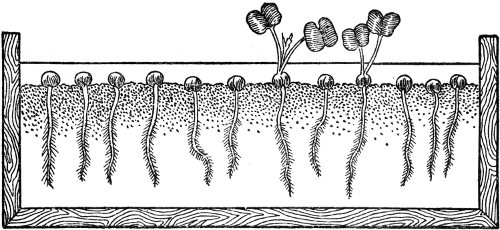
A Box of Mustard Seeds.
A whole week went by before Uncle George was ready for the next lesson.
At last he called the children and said to them—“Tom, will you please fetch me the seeds which we put on the wet blotting-paper under the tumbler? Frank, bring me two leafy branches from a rose-bush in the garden; and, Dolly, please fetch two glasses from the kitchen.”
Now there was nothing the children liked better than to help their Uncle George, and all three rushed off at once to do his bidding.
While they were away Uncle George himself 14 went into the garden, dug up two young plants, and brought them to the children in the study.
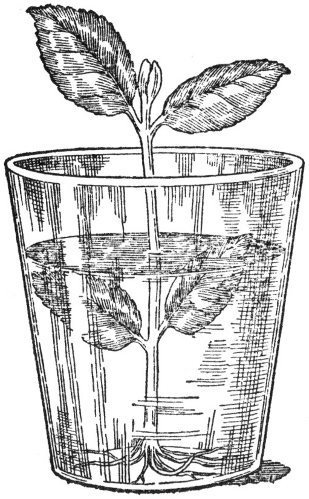
Sun-flower Plant in Water.
“Now, children,” said Uncle George, “we are ready to begin our lesson. Fill one of the glasses with water, Frank, and put one of your leafy rose branches in each glass—one branch in water and the other in a dry glass. Can you tell me what will happen to the branches?”
The children had many times seen what had happened to flowers when the maid had forgotten to put water in the vases, so that Tom readily said, “Yes, the one in the dry glass will wither, while the one in the water will keep fresh for some time.”
“How do you know that?”
“Because it always happens, Uncle,” said Frank. “Why, sometimes the flowers we gather in the wood are faded before we get home. They often come back to life when put in water.”
“You are quite right, Frank,” Uncle 15 George replied. “See, here are two young sun-flower plants, which I brought in from the garden. I placed one in water. The other I left lying on the table. The one on the table is dead. What does this show us?”
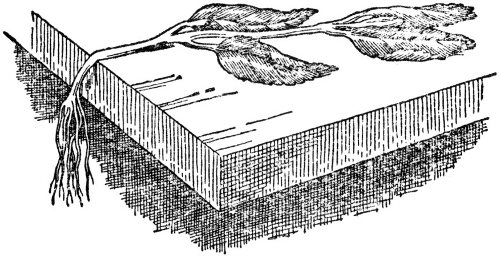
The Sun-flower, faded.
“That plants require water,” said Tom. “That whenever you cut off their water supply they die.”
“Quite right, Tom. We shall see by and by that plants are always giving off a great deal of water to the air from their leaves.[1] Where do they get this water from?”
“It must be from the soil,” said Frank.
“It must be,” said Uncle George. “If we keep a plant in a pot without watering it, it soon dies. All the water it contains will by and by travel up to the leaves. It passes out through tiny pores in the leaves into the air. If no more water comes up from the soil, the plant withers and dies. The roots of plants search the soil in all directions for 16 water. And in this water there is but little plant-food. We saw this when we boiled away the clear water which covered the soil in the glass.
“If we boil away some water from the tap, we shall find some solid matter left behind in the dish. Thus we see that in order to get a small quantity of food, plants take up a great quantity of water from the soil. Most of the water is sent into the air from the leaves. But the food stuff remains in the plant, just as it did in the dish.
“Now I am going to show you how this water gets into the plant. Look at these little seeds on the damp blotting-paper!
“Each seed has a small plant with a long root, and small, stout green leaves. Look at the roots and tell me what you see?”
“They are covered with silky stuff,” said Frank.
“Yes. Now take this glass, which will make things look bigger than they really are, and look at the roots once more.”
“The silky stuff is a number of fine hairs,” said Frank.
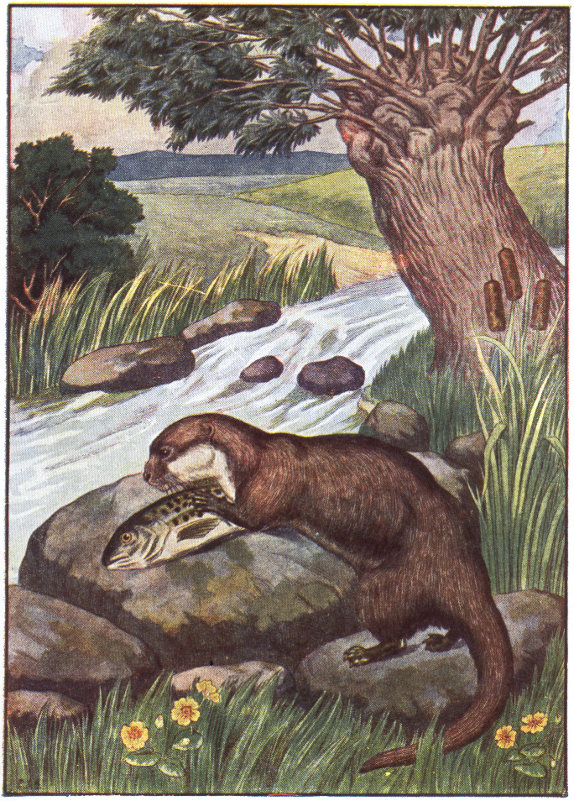
THE OTTER
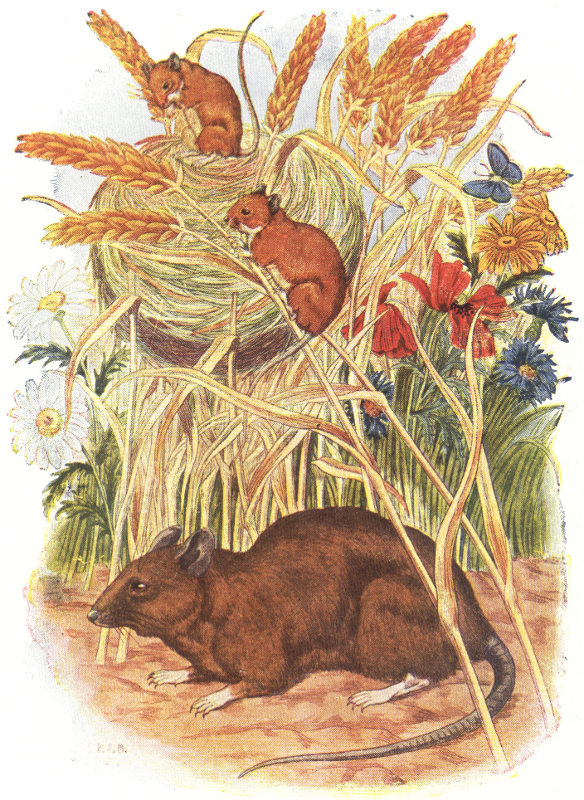
FIELD-MICE
“That is quite right, Frank,” said Uncle George. “These are the root-hairs. Each of these hairs is a long bag or sac, of very thin skin. It is filled with a liquid called sap, which is slightly denser, or heavier, than the water in the blotting-paper. Now, do you see how a plant takes food from the soil, when it is growing in the garden or in a field?”
“Yes, I think I do,” said Frank. “The water in the soil contains very little plant-food. The water inside the tiny sac contains very much.”
“And what have you to say, Tom?”
“One of these liquids is denser than the other,” said Tom. “Both are separated by a thin skin. The lighter liquid outside the sac will pass into it quickly, while the heavier liquid will pass out slowly.”
“Bravo! Tom!” said Uncle George. “I couldn’t have given a better reply myself. The water from the soil passes in quickly. The sap from the inside of each root-hair passes out slowly. If they were both of the same density, neither would pass through the skin. If the water in the soil were the denser, then the sap would pass out so quickly that the plant would soon be robbed of its water.
“Here are two young plants, each growing 18 in a small pot. I want you to water them, Tom. Water one with salt and water (brine), the other with tap-water.”
Tom did as he was asked.
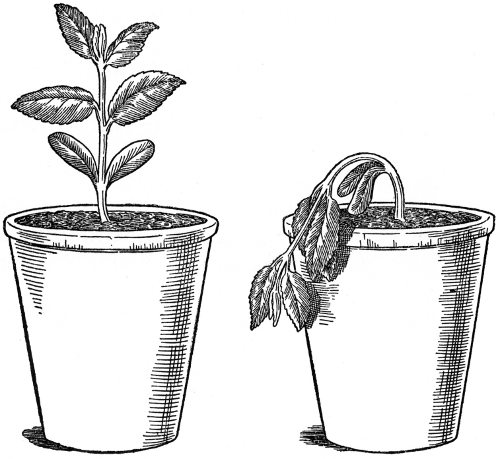
Plants watered with Fresh and Salt Water.
“See,” said Uncle George, “the one which you watered with brine is drooping. It is bending over the pot. That is because the water outside its root-hairs is denser than that which is inside the plant.”
“How does the water get up from the roots to the leaves?” Frank asked.
“Just in the same way as the oil travels up the wick of the lamp. Water will always travel up through small spaces.”
Uncle George poured some red ink into a saucer, and dipped the corner of a lump of sugar into it. The red ink ran up into the sugar until it was red all over. Next he took a bundle of very small glass tubes, and dipped the ends of them in the ink. The ink ran up the tubes, filling them to the top.
“Inside every plant,” Uncle George went on, “there are thousands of long tiny tubes, up which the water travels. In fact the veins of a leaf are just bundles of tubes, something like the bundle I hold in my hand.”
It was Frank who wanted to follow the stream far up towards the hills. He wished to see where it began, for he had heard that its source was in several small streams many miles away.
Uncle George agreed to take the children as far up the stream as they could walk, without being tired. Soon they were far up above the wood, and the fields, and the pond.
Frank was not in the least sorry when his uncle sat down on a large stone by the side of the stream.
“We shall not go much farther,” said Uncle George. “Some other day we will. But tell me what you think of the country round about you.”
“It is very wild and lonely,” said Tom. “There are no fields of corn; nothing but green hills and moorland. Yet it is very grand.”
“The flowers and plants are not like those of the valley,” said Tom. “The stream, too, is different. Here it is a noisy, rushing course of clear, lovely water. Down below it is a lazy-flowing stream.”
“It is not always so clear,” said Uncle George. “After heavy rains this stream is swollen and brown.”
“Look! look!” cried Dolly. “What is that on the other side of the stream?”
Sure enough there was something moving about. Now it turned round and opened its mouth, showing two rows of sharp, white teeth. Then, with a harsh cry that could be heard above the noise of the water, it bolted away.
There was just time for all to see the creature, which Tom at once called a weasel.
“Yes, a weasel it is,” said Uncle George; “it is one of the animals which prey on rabbits and young hares. Look! there it is again.”
The children looked, and saw it quite clearly. There it was, a pretty little animal of a black and brown colour, with just a little white on its breast. It sat up, and was holding something in its fore paws.
“Ah!” said Uncle George, “our little friend is a thief. He has found a nest, and that is an egg he has stolen from it. Let us see what he will do with it.”
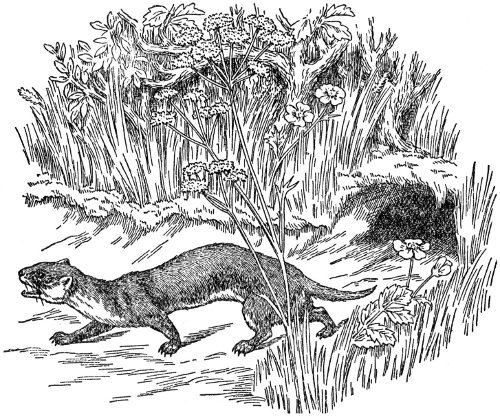
The Weasel at Home.
In a moment or two Master Weasel tucked the egg under his chin and was off once more.
“What a dear little thing, to be sure!” 23 said Dolly. “How quaint to carry an egg in that way!”
“It looks pretty, that is certain,” said Uncle George, “but it is a dreadful foe to the smaller animals of the field. There are other foes, too, and I hope we may see some of them before we return.”
The boys were glad to hear their uncle say this, and they asked him to take them, now they were rested, a little farther up the stream.
All of them made a start.
By and by they came to a place where the stream made a kind of pool. The pool was bounded on each side by high rocks. At the top end the water came down with a rush from a great height.
It was a very lonely spot indeed; and, except for the noise of the water, nothing could be heard.
On and on they went.
Uncle George told them of the stoat, the polecat, and the marten, all of which, he said, were foes of the smaller animals.
Tom kept a sharp look out, and hoped he would see at least one of these.
As luck would have it, a dull splash was 24 heard in the water a little way in front of them. All of them looked towards the spot.
“Down, boys, down! and keep quite still,” said Uncle George. “Hide behind these big stones. We shall have a treat.”
Swimming on the surface of the water was an animal as large as a good-sized dog. Now it dived to the bottom. The ripples on the water showed that the animal was swimming underneath. The children held their breaths and watched. Not in vain; for there, on the other side of the stream, the animal came out of the water. It held a fish which it had caught.
“Now,” said Uncle George, “we have a fine chance to look at our new friend. That animal is the otter. See! Its body is pretty flat; its legs are short, and its toes are webbed like those of the duck. Look at its round nose and its small ears. If we were closer to it we should see that there is a fold of skin which can be turned over the ears while the creature is in the water.”
“How fierce it looks!” broke in Dolly, “and how its eyes gleam!”
“It is glad to have caught the fish, I should think,” said Frank.
Uncle George raised his hand to hold the children in silence. Then he went on in a soft voice. “Look at its flat tail, which is pointed at the tip. The otter uses his tail as a rudder to guide him in the water. See how sleek his dark brown skin is. It is now nearly dry, though he has only just come out of the stream.”
“Let us drive him away,” said Dolly, who could not help but feel sorry for the poor fish.
There was no need for this, however, as, just at that moment, the otter turned towards the party, showing, as he did so, a lovely white throat. He had heard them speaking, and was off like a flash, leaving the fish on the rock.
The fish had an ugly bite in its back, and was quite dead.
“Poor, dear little thing!” cried Dolly. “What a shame to kill you!”
“It is the otter’s nature,” said Uncle George. “He does a great deal of good, for he kills many water-voles, or rats, as they are sometimes called, as well as frogs and water insects. Sometimes, however, he does harm, for he catches salmon, trout, and wild-ducks. 26 He seems to do this more for sport than for food, for he only eats small portions of his prey.”
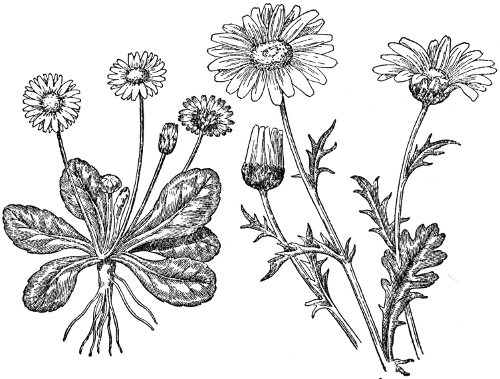
Common and Ox-eye Daisy compared.
As Uncle George walked by the edge of the corn field, Dolly and her two brothers ran up to him. Dolly carried a bunch of huge daisies in her hand.
“We want you to tell us about these, Uncle George,” she said. “Tom says that these are the little field daisies grown up; and Frank says they are not.”
“Frank is right,” said Uncle George, laughing. “This is not the common field daisy. It is the ox-eye daisy. You might 28 bring me a common daisy, Frank. I am sure there are many growing near. Ah, here is one at our feet! Now let us hold them side by side.
“You can see that they are unlike one another in many ways. The ox-eye daisy has much larger leaves and flowers. It bears its leaves and flowers on tall, strong stalks. The leaves of the common daisy lie almost flat on the ground, and there is only one little flower-head on each stalk. When we get home we shall look at them both more closely.”
“Oh, look at those big yellow daisies growing among the corn,” said Dolly.
“And I see some blue flowers near them,” said Tom.
“The yellow flower is the moon-daisy. It is also called the corn-marigold. It is a great deal like the two daisies we have just been talking about. The other is the blue cornflower. It belongs to the same great family as the daisies. Frank will go and fetch us some.”
Frank gathered a bunch of both flowers. He was just reaching over for some large red poppies when he saw a pair of small black cunning eyes peering at him. Then a brown 29 creature ran past him and went out of sight among the long grass at the edge of the field.
“A rat! a rat! Uncle George!” he shouted.
“Yes, it is a rat, I saw it,” said his uncle.
“But what is he doing out in the fields?” said Frank. “I always thought that rats lived in houses.”
“The brown rat lives where he can,” said Uncle George. “Very likely this one has come from the farm. Farm-yard rats often come out and live among the long grass and reeds in summer-time. When the cold weather comes, and the crops are gathered, they go back to the stables and barns. There they rob the farmer. They are very cunning creatures. They steal eggs, milk, grain, and even kill and carry away young chickens. The rat lives by thieving. That is why he is killed whenever he shows his face.
“Rats are sometimes useful, though. They swarm in ship docks and places where stuff is left about. They eat up what would rot and poison the air. They thus help to keep down disease.
“Now, boys, before we go home I am going to show you something. I found it the other day when taking a walk.”
Uncle George led the children to the end of the field, and pointed to a strange object among the corn. It was a nest of some sort. It was made of dried grass, and hung from five or six wheat stalks. It was round like a cricket-ball, and just about as big.
“It is the nest of the harvest-mouse,” said Uncle George in a low voice. “Keep still, and perhaps we shall see Mistress Mousie.”
The children waited a long time looking at the curious little object. At last a tiny brown creature ran up one of the wheat stalks and went into the nest. It seemed to go right through the wall of its little house. There was no hole to be seen where it went in. Then Uncle George clapped his hands. At once two wee brown mice came out.
They slid down the corn stalks and were out of sight in a moment.
“Ha! Mr and Mrs Mousie, we have disturbed you,” said Uncle George. “We will now go nearer and see your nest.”
“I can’t see where they came out,” said Tom. “There is no hole to be seen.”
Uncle George pointed out to the children how the nest was woven together and fixed to the wheat stalks. He then took a pencil from his pocket and moved aside some of the dried grass. The children looked in and saw a family of naked little mice cuddled up together. They could not tell how many there were; but Uncle George said that there were eight or nine young ones as a rule in a harvest-mouse’s nest.
“What will become of these wee mice when the corn is ripe?” Tom asked.
“They will perhaps be grown up and able to take care of themselves by that time, Tom,” said Uncle George.
“The harvest-mouse stores up corn in its nest. Before winter comes it makes a hole in the ground. Here it sleeps through most of the winter and spring. It wakes up from time to time and feeds upon its store of grains.”
“It is much smaller and browner than our house-mouse,” said Frank.
“Yes, Frank, it is our smallest four-footed animal. We have many kinds of mice in this 32 country. The brown rat is the largest and the harvest-mouse is the smallest of our mouse family.”
“How does it manage to slide down the wheat stalk so quickly without falling off?” Tom asked.
“It can use its long tail as well as its feet for climbing,” his uncle answered.
“When it wishes to get to the ground it just coils its little tail round the stalk and slides down.”
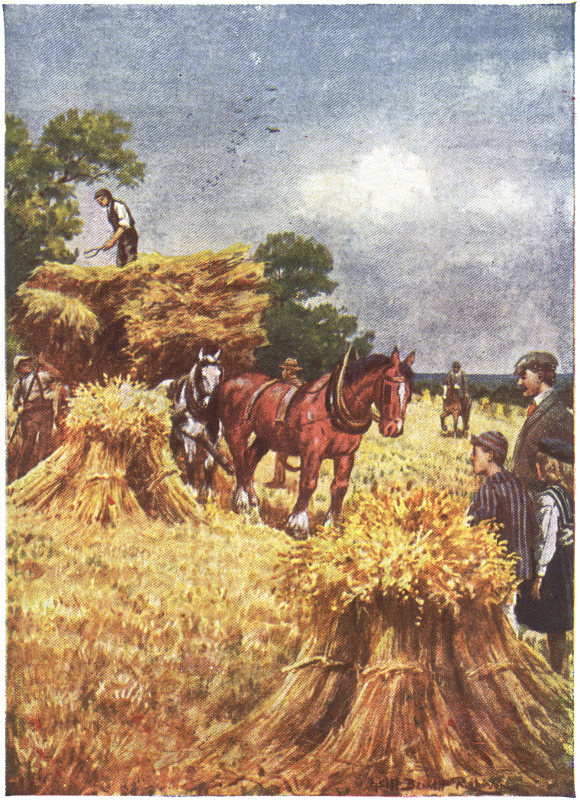
HARVEST TIME
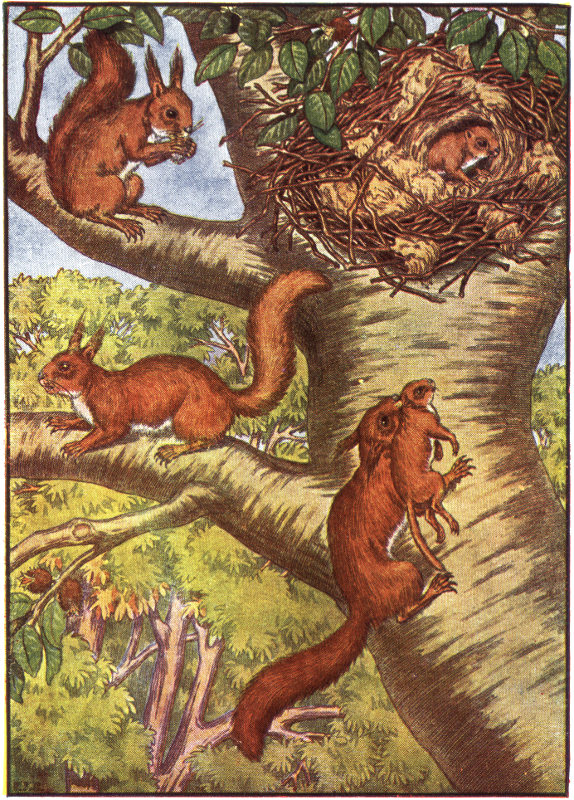
THE SQUIRREL
“They are very busy here,” said Uncle George, as he went into the field with Frank, Tom, and Dolly.
And well might he say so, for the whirr of the reaping-machine could be heard far away. Round the field it went, sweeping down the golden wheat. Following behind it were several girls, who twisted bands of straw and laid them on the ground. Behind these came women who quickly gathered up the cut wheat and placed it in bundles upon the bands. Then came men who bound these bundles into sheaves and tossed them aside. After these, again, came men who caught up the sheaves and placed them upright in bunches of six or eight. These bunches of sheaves they called “stooks.” Last of all came a huge rake drawn by horses, gathering up all the straws that were left. Every now 34 and then the man that guided the rake pressed an iron bar, and, whenever he did so, all the teeth of the rake rose up at once, and left a row of gathered straw on the field. Then a man came and bound them into rough sheaves as before.
All was work and bustle and noise. What with the whirr of the reaping-machine, the girls singing as they worked, the larks singing in the sky, and the glorious autumn sun, the children thought the harvest-field was the most cheerful place they had ever seen.
“Why do you do that?” Frank asked a man who was fixing up the stooks. “Would it not be just as well if you left the sheaves lying on the ground until you cart them away?”
“Ah, no, Master Frank,” said the man, who knew him well, “that would never do. We must allow the corn time to get dry, so we place the sheaves upright that the sun and wind may dry them; and so that any rain that falls may run down the stalks to the ground. When the sheaves are quite dry, we take them home to the stack-yard.”
“How long does that take?” Frank asked.
“It all depends on the weather,” the man replied. “If it keeps fine, they will be dry within a week. In rainy weather, sometimes the sheaves have to stand in the fields for some weeks. In the next field the crop was cut a week ago. They are taking it home now.”
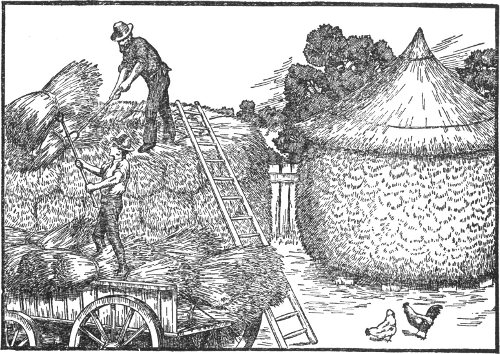
The Stack-yard.
“And you build the sheaves into great stacks there?” said Tom.
“Yes, it is kept in stacks until we are ready to thresh it. You must all come over to the farm and see it being threshed into grain and straw some day.”
“But why do you build it into stacks?” asked Frank.
“So that we may keep it through the winter, and thresh a stack at a time as we need it,” the man replied. “It is threshed by passing it through a mill. At our farm the mill is turned by horses. At some farms there are mills turned by a great water-wheel. Sometimes a steam-engine comes and threshes the whole crop in the fields.”
“And what do you do with it when it is threshed?” Dolly asked.
“When the corn is passed through the mill, it is so shaken up that all the grain is removed from the stalks. The grain comes out at one side of the mill and falls into sacks. The straw is tossed out at another part. We use the straw for bedding for horses and cows, and some kinds of straw we use for feeding them. The grain goes to the miller, who grinds it into flour. The 37 flour goes to the baker, who bakes it into bread.”
“Come along, boys!” Uncle George shouted from the next field. “We are going over to the farmyard to see the stacks made.”
In the next field the farmer’s men were loading a waggon with sheaves of corn. The sheaves were caught up by long pitch-forks and tossed on to the waggon. Here a man put them into a great square load. When this was done, the men lifted Dolly up, and she rode up to the farmyard on the top of the great load of sheaves.
In the stack-yard a large round stack was being built. A wooden frame was in the middle, and round this a man put the sheaves in a circle as they were thrown to him from the waggon.
“Now, boys,” said Uncle George, “Dolly wants to know why sheaves are made with all the ears of corn at one end. Can you tell us?”
“Oh, that is easy,” said Tom. “The sheaves have to stand in the field for a long time to dry. They could not stand up so well if they were made any other way. Besides, 38 the ears of corn must be up from the ground, or they would be broken off.”
“There is another reason,” said Uncle George. “Look how the stack is being made. The top, or grain end of the sheaf is inside. The outside of the stack is made up of the cut ends of the straws. Thus the grain is kept secure from bad weather and thieving birds. Besides, the stack could not be made round in shape if they were placed in any other way. The bottom of the sheaf is much wider than the top.”
In another part of the yard men were busy roofing the newly built stacks with straw. The straw roof was tied down with many ropes, also made of twisted straw, and then the stack was ready.
“What a lot of work there is in getting corn,” said Frank.
“Ah, yes,” said his uncle, “much more work than we have seen to-day. Think of the work done in the fields in spring, getting the land ready for seed—the work of ploughing, sowing, reaping, and threshing done by the farmer’s men and horses—the work done by the rain and sun in growing and ripening the wheat—the work done by the miller and 39 baker; and all this, Frank, that we may have a loaf of bread.”
“Halloa! there he goes again,” said Frank, as he watched a nimble little animal leaping from branch to branch, and from tree-top to tree-top. “He will fall if he does not take care.”
“No fear of that,” said Uncle George. “His home is among the tree-tops. He never falls. That is a squirrel, and I should not be surprised if his nest is somewhere near. Let us sit down on this bank and watch.”
As he spoke, Uncle George took his pair of field-glasses out of the leather case which he sometimes carried on a strap across his shoulder, when he went out to watch the birds.
“Now, Mr Squirrel,” he said, “we can watch your antics from a distance. You are a very cunning and clever little chap, no doubt.”
When Uncle George and Dolly and the two boys first saw the squirrel, the little creature was on the ground, bobbing about among the ferns and the grass. The moment it saw them, however, it bounded into a tree, going swiftly up by jerk after jerk, and always keeping on the far side of the trunk.
They could just see its bushy tail, first at one side of the trunk and then, much higher up, at the other side. When it reached the top part of the tree, it leapt from branch to branch in the most daring manner.
“We have alarmed the creature,” said Uncle George. “But if we sit here quite still for a little while, Mr Squirrel will get over his fright. Ah, there he is.”
Uncle George handed the glasses to Frank.
“Now, tell us what you see,” he said, “and then Tom and Dolly shall each take a look.”
“He is sitting up on his hind legs,” said Frank. “His great, bushy tail is bent right over his head. He is holding a little green thing in his fore-paws. Ah, he is eating it. Look Dolly!” and Frank handed the glasses to his little sister.
“Oh, what a lovely little animal,” said Dolly; “and what pretty eyes he has. They are just like a pair of bright, black beads.”
“I think Tom ought to have the glasses now,” said Uncle George. “He has been very patient indeed. Come Tom, tell us what the squirrel is like.”
Tom took the glasses and looked through them for a long time. Then he said, “He is a very pretty creature, as Dolly has said. His colour is rich brown all over, except the front part of his body, which is a very light brown, changing almost to white. His tail is very large and bushy, and his ears are upright and tufted with brown hair. His fore-paws are just like little hands. He holds the nut in them and nibbles it just like a little monkey. His head is not unlike the rabbit’s head. His teeth are almost exactly like rabbit’s teeth. They are chisel-shaped, and seem to be very sharp.”
“Splendid, Tom,” said his uncle, patting him on the back, “I don’t think you have left anything out. Now, let me look.”
“Oh, there is another one. There are now two of them,” said Frank.
“Where did that one come from?” asked 43 his uncle, looking through the glasses. “It seemed to come out of the tree, did it not?”
“I thought you children would leave me nothing to find out; but I see something which you have missed. Here, Frank, take the glasses and see if you can find it. Look at the fork of the tree just below where the squirrels are.”
“I see something like a nest,” said Frank. “I noticed that before, but I thought it was a rook’s nest.”
“Nay,” said his uncle, “it is a squirrel’s nest. Rooks build on the very top branches of trees, and you never see one rook’s nest without a lot of others near it. Besides, the rook’s nest is a rough flat nest, while this is a round one with a roof on it, and a hole in the side to let the squirrels out and in.”
“Then that other squirrel must have come out of the nest,” said Frank.
“Just so,” said Uncle George. “That is Mrs Squirrel. She has come out to get some food, and her little husband will look after the family while she is away hunting for nuts and buds and soft green bark.
“If we could get up to that nest, we should find it to be built of twigs and moss cleverly woven together.
“The inside is lined with soft warm moss and dry leaves. We should, most likely, find four or more tiny squirrels cuddled up together inside. Blind, naked, helpless things they are at first. But they soon grow up, and their long bare tails become bushy. Then the little mother teaches them to climb and find food for themselves. Should one of them fall, she springs down and carries it up to the nest in her mouth, just as a cat carries her kittens.
“By autumn these young squirrels will be quite as clever as their parents. Autumn is the squirrel’s busy time. He has to prepare for the long winter, for no nuts are to be found then. So the squirrel gathers in his harvest of nuts. These he hides in secret places buried in the ground. He usually has more than one storing-place. In fact, he sometimes has so many that he forgets about some of them.”
“We never see squirrels in winter,” said Tom.
“No, because the squirrel sleeps the whole 45 winter through. After he has gathered his harvest, he looks for a snug hole deep under an old tree-stump. This he lines with dry leaves and pieces of bark. When the weather becomes very cold he seeks his winter nest, coils his body up so that his great tail is folded almost right round him, and falls fast asleep. Cold makes him drowsy, but warmth wakes him up. On a mild winter’s day he wakes up, crawls out of his hole, and visits his store of nuts. After he has made a good meal of them, he goes back to his bed again, and sleeps on until hunger and mild weather wake him up.
“During autumn the squirrel’s coat is very pretty. It is of a deep, rich brown colour, and very thick. His tail is then very large and bushy, and he is quite fat and sleek.
“When he comes out of his sleeping quarters in spring he is thin and hungry. His coat is then a very pale brown.”
“What does he do for food in spring?” asked Tom. “There are no nuts to be found then.”
“Alas, no, Tom. In spring he robs birds’ nests of their eggs, and that is why the 46 pretty little squirrel is hunted and shot by the game-keeper. In spring, too, he feeds on the tender buds, and so does much damage to trees and shrubs; that is, if his winter stores are used up.”
“I should think,” said Frank, “that such a large tail would be very much in the squirrel’s way when climbing and leaping from branch to branch.”
“Not at all,” said his uncle, “his huge tail is of the greatest use to him in guiding his body. Without it he could not take such flying leaps among the tree-tops.
“Besides this, it often enables him to escape from his enemies. Many a time the game-keeper’s bullets pass harmlessly through his fluffy tail, while Mr Squirrel scampers safely up the tree; and many a time he escapes from the cat by leaving the tip of his brush in pussy’s claws.
“A great many of our trees have been planted by squirrels. Many a stately oak and beech tree has sprung from the squirrel’s buried store of acorns and beech nuts. For, as I have already told you, sometimes he forgets where he has buried them, or perhaps fails to find them when the forest is white 47 with snow. So, you see, the little animal is of some use after all.”
It was a cold wet day—so cold and wet that neither Dolly nor her brothers could venture out. They had grown tired of reading books and drawing pictures, and were indeed feeling very dull. They sat looking at the bright fire. Uncle George laid down his paper and said:
“Come, let us have a lesson. What shall it be? The rain? The cat? Or shall it be the cosy fireside?”
“The fire,” said Frank. “Tell us why the fire burns, Uncle George!”
“I will,” said cheery Uncle George. “Just wait until I get some things from the kitchen. Come along, boys.”
When Uncle George and the boys came back to the room, they brought a lot of curious articles with them. These were an empty pickle-bottle, a small saucer, a glass bell-jar, a large dish, a piece of candle, some tacks, and a taper.
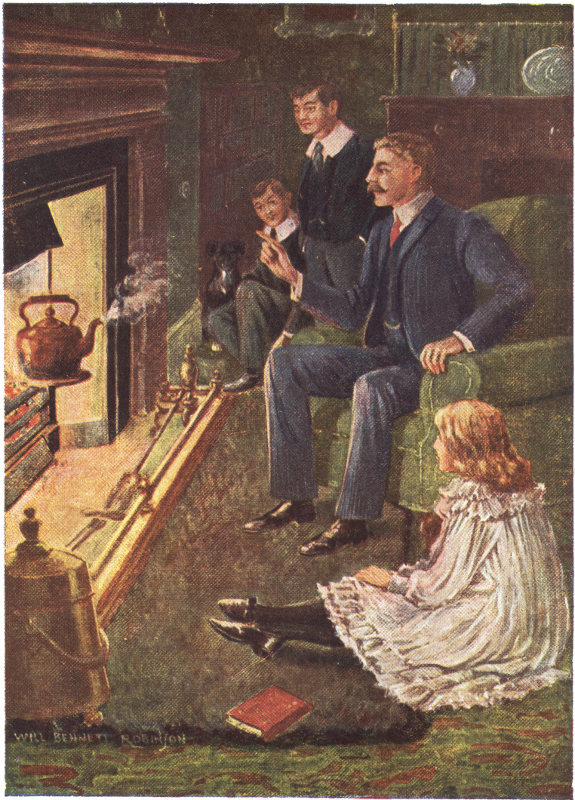
A Baby Cloud
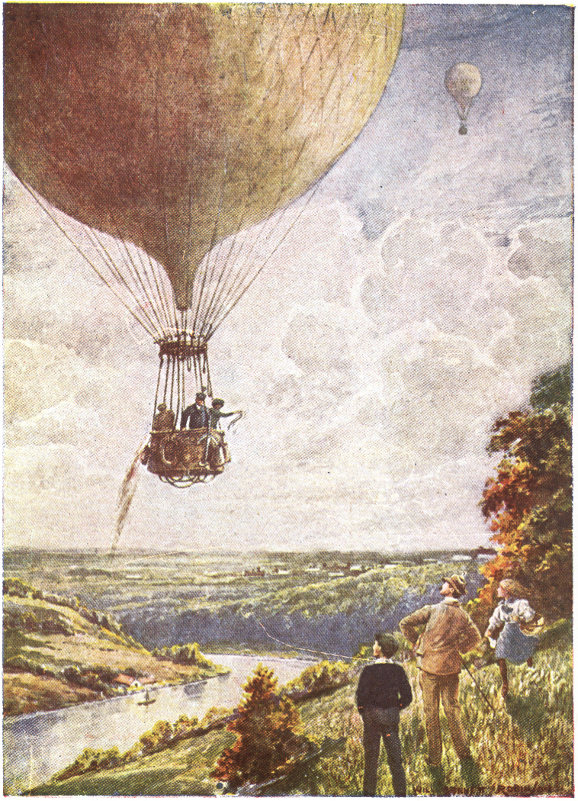
THE BALLOON
“Now,” said Uncle George, “we are ready to begin.”
He first lighted the piece of candle and lowered it into the bottle. It burned for a short time, then it went out.
“Can you tell me why it goes out?” he asked.
“Want of air,” said Tom and Frank at the same time.
“But there is air in the bottle,” said Uncle George.
“Yes, but not the kind of air the candle wants,” said Frank.
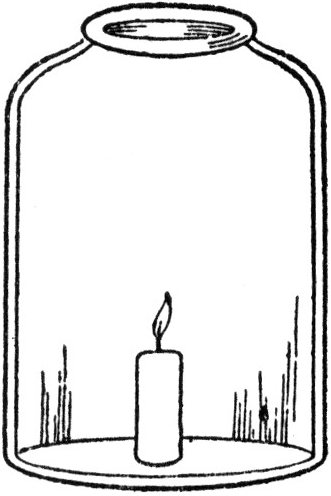
Candle burning in Open Jar.
“That is a queer answer, Frank. The candle burned for a time in the bottle before it went out.”
“Because it used up that part of the air which makes things burn,” said Frank.
“That is very good,” said Uncle George.
Uncle George then poured some water into the large dish. He fixed the candle on a big cork, lighted it and set it floating on the water. Then he placed the glass 50 bell-jar over it. But first of all he marked the level of the water on the outside of the bell-jar.
Very soon the flame of the candle became small, and at last went out. Just then the water inside the bell-jar rose far up above Uncle George’s mark. He marked this new level, and asked the boys if they could tell him why the water rose in the jar.
Both Frank and Tom shook their heads sadly.
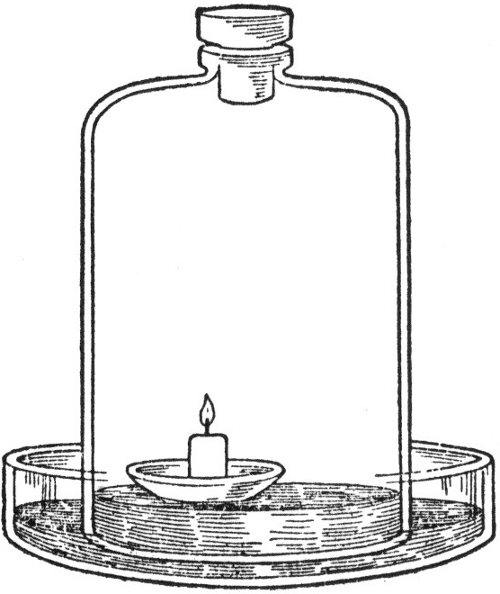
Candle in Stoppered Jar—burning.
“Then I must explain,” said Uncle George.
“Some of the air has gone,” said Tom.
“Yes,” said Uncle George. “How much of the air has gone?”
Frank pointed to the space between the two marks.
“That is right,” said Uncle George. “The water has risen up in the bell-jar to take the place of the air that has been used up by the burning of the candle. Where has this used-up air gone?”
“It must have gone into the water,” said Tom.
“Why did it not go into the water before the candle burned?”
“Perhaps the burning of the candle has changed this part of the air,” said Frank.
“Very good, Frank. You are right again. The burning of the candle has changed a certain part of the air. It has, indeed, so changed it that it can dissolve in water just as if it were sugar or salt.”
Uncle George now poured water into the outer dish until it was level with the water inside the bell-jar. Then he took out the stopper and pushed a lighted taper into the bell-jar. The taper at once went out.
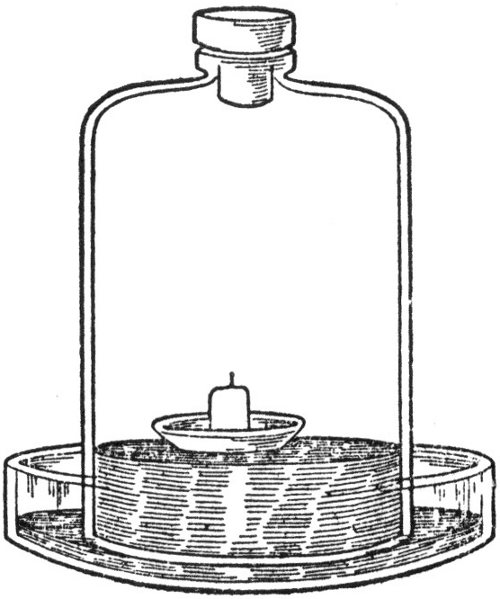
Candle in Stoppered Jar—gone out.
“This shows us,” he said, “that a part of the air causes things to burn. The other part of the air does not. It puts burning things out. If we blow the fire with a bellows or 52 fan, it burns more brightly and quickly. Why? Just because we are forcing a stream of air upon it, and a part of that stream of air is changed by the burning.”
Uncle George next put some bright iron tacks in a small dish. He poured some water out of the large dish, and placed the bell-jar in the dish. After that he added water until it was just up to his first mark on the bell-jar.
Then he floated the dish with the tacks on the water. Next he wetted the tacks with water, and then placed the bell-jar over them and put in the stopper.
“Now,” he said, “we will leave this just as it is for a few days.”
The boys watched the bell-jar every day, and this is what they saw. The water rose slowly in the bell-jar. As it rose the bright tacks turned red with rust. The water rose higher and the tacks turned redder every day.
At length it rose to Uncle George’s second mark. It rose no farther, although left for a whole week.
Then Uncle George called the boys and 53 asked them what had taken place in the bell-jar.
“The tacks have rusted, and some of the air in the jar has been used up,” said Frank.
“How much air has been used up?” Uncle George asked.
“Just exactly the same as was used up when we burned the candle,” said Tom, pointing to the top mark.
“Let us see, then,” said Uncle George, “what part of the air has gone.”
He poured water into the large dish until it was level with the water inside the bell-jar. Then he put a lighted taper into the bell-jar as before. It went out at once.
“It is the same part of the air as the burning candle used up,” said Frank.
“Then we have found out,” said Uncle George, “that when a thing burns it uses up a certain part of the air; and that when iron rusts, exactly the same part of the air is used up.
“In the first case, the burning of the candle changed part of the air into a gas which dissolved in the water. In this case, that same part of the air has joined up to part of 54 the iron tacks to form that red powder which we call rust.”
One day Uncle George made the children a fire-balloon. He took twelve strips of tissue-paper shaped as you see in the picture. These he pasted neatly together at the edges so as to form a kind of bag with a round opening at the bottom. A ring of wire was then fixed at the bottom to keep it firm, and across the ring was stretched another piece of wire. This was to hold a dry sponge by and by.
Uncle George swung the balloon till it was filled with air. He told Frank to hold it by the ring while he heated the air inside the balloon.
This was done by holding the mouth of the balloon over a piece of rag which had been dipped in spirits and set on fire.

Strip for Balloon.
Soon Frank felt the balloon rising. He lifted it up away from the flame, while Uncle George moved the little sponge along the wire to the middle of the ring. Then he soaked the sponge with spirits and set fire to it.
“Let go!” said Uncle George; and away went the balloon, soaring up towards the sky. Higher and higher it rose, moving with the wind. The children watched it until at last it seemed a mere dot in the sky, and then it went quite out of sight.
“What makes the balloon rise up?” Dolly asked, as they returned to the house.
For answer Uncle George took a cork and held it under a trough of water. When he let it go, the cork at once rose to the top of the water.
“What makes the cork rise up?” he asked.
“Because it is lighter than the water,” said Tom.
“For just the same reason the balloon rises in the air,” said Uncle George. “Our balloon is only a bag filled with air.”
“Then the air inside the balloon is lighter than that outside,” said Frank.
“Yes,” said his uncle. “What did we do to it to make it lighter?”
“We heated it,” said Tom.
“And what has this taught you?” asked Uncle George.
“It has taught us,” said Frank, “that if we heat air we make it lighter.”
“What takes place is this,” said Uncle George. “When a small quantity of air is heated it swells out and fills a much larger space than before. It therefore becomes much lighter than the air round about it, and rises up through it. Come into the house and let us take another lesson from the fire.
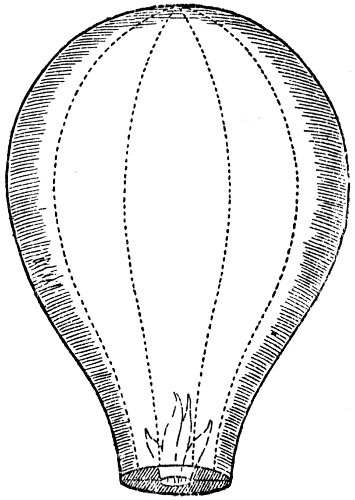
Strips pasted together.
“We have already learned that the fire in burning uses up part of the air. After using up this part of the air, how is it that the fire does not go out?”
“Because there is always a fresh supply of air coming into the grate!” said Frank.
“Quite right. If we stand between the 58 door and the fire we can feel this stream of air. Something else is taking place in the grate besides the burning of coal. What is it, Tom?”
“Air is being heated!”
“Very good, Tom, and what becomes of the heated air?”
“It rises up the chimney, carrying the smoke with it; just as the heated air in our balloon rose up, carrying the paper bag with it,” said Frank.
“That is really a clever answer, Frank. Now, can you tell me what makes this constant stream of cold air from the door to the fireplace?”
“It is the cold air rushing in to take the place of the heated air that has gone up the chimney,” said Frank.
“Very good indeed, Frank,” said Uncle George. “And now I am going to show you something which will prove all this very nicely.”
He then took a saucer and poured some water into it. He placed a piece of lighted candle in the middle of the dish and put a lamp chimney over it. The candle burned for a few seconds and then went out.
“Why does the candle go out?” he asked.
“Because it has used up that part of the air which makes things burn,” said Tom.
“That is right,” said Uncle George, and he began to cut a piece of stout card, shaped like the letter T, but broader every way. The upright part fitted into the top of the lamp chimney.
“We are now going to give the candle flame a stream of fresh air,” he said, as he fitted the piece of card into the chimney.
The candle was again lit and the chimney placed over it. This time it did not go out. It burned brightly, and the flame seemed to be blown from side to side.
“That is very strange,” said Frank.
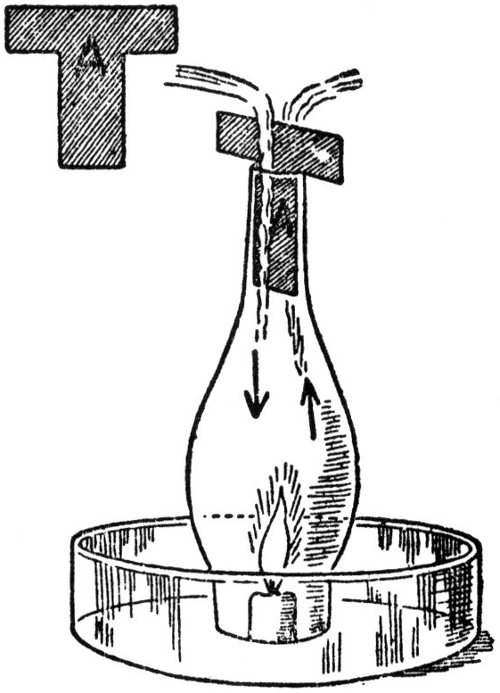
Draught in Chimney Glass.
Uncle George lit a piece of brown paper. “You will understand it now,” he said, as he held smoking paper near the top of the chimney.
Then the boys saw a stream of smoke go 60 down one side of the card and come up the other side.
“Oh, I see it now,” said Tom. “The card divides the chimney into two. The air, heated by the candle flame, rises up one side of the card, and the cold air goes down the other side to supply its place, drawing the smoke with it. The candle does not go out now, because it gets a constant stream of fresh air.”
“Are the balloons, which are large enough to carry people, fire-balloons?” asked Dolly.
“No, my dear,” replied Uncle George. “They are filled with a gas that is lighter—very much lighter—than the air. They rise up easily, and can carry quite a heavy load.”
Frank, Tom, and Dolly had never seen the sea. Long ago Uncle George had told them that he would take them, and at last the time came for them to go.
It was afternoon when they reached the little sea-side village where they were to spend a few days. The children were filled with wonder when they saw the great, restless ocean. They watched the waves breaking into white surf, and gathered sea-weeds and shells on the sandy beach.
By and by they all sat down to rest and to watch the gulls, for there were many here-about.
“We have seen birds like these before, have we not?” said Uncle George.
“Yes,” said Tom, “we see them at home in the fields at spring-time. But are these the same kind of gulls?”
“Yes, Tom, they are. There are several 62 kinds of gulls. Here we have just two kinds. The common gull and the tern. You can tell the one from the other even in the distance by their mode of flying.
“Do you see that one flying rapidly over the sea? Every now and then he swoops down to the water and skims along, almost touching it with the tips of his long, pointed wings. Do you know any other bird that flies like that?”
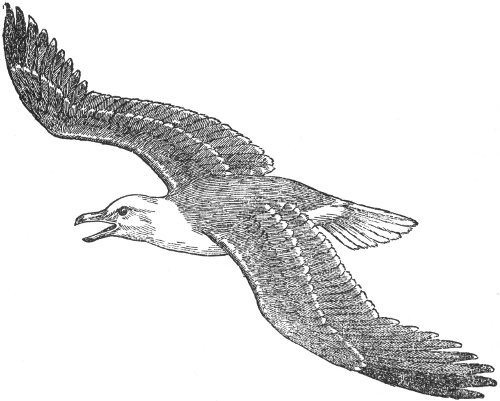
Gull flying.
“The swallow flies over the lake at home something like that,” said Frank.
“That is so,” said Uncle George. “The 63 tern is very like the swallow both in shape and in his manner of flight. He differs, however, in size and colour. He is often called the ‘sea-swallow,’ and is the smallest of the gull family.
“Your swallows at home catch flies and other insects as they skim through the air. The ‘sea-swallows’ live on fish. Every time they dart down they seize and swallow a little fish. But it is done so quickly that you cannot see it.
“The gull’s flight is quite different. Sometimes he flies so lazily that he does not seem to move onwards at all. Then all of a sudden he darts down into the water to seize his prey. Sometimes he flaps his great white wings and wheels swiftly away, flying in great circles until he is a mere speck in the distance. The gull has a very sharp eye. Watch!”
Uncle George threw a piece of bread into the sea. At once about a score of gulls pounced upon it, screaming loudly. Uncle George waited until they flew away. Then he threw them a piece of wood. None of the gulls came near it.
“You see,” he went on, “they can tell a 64 piece of bread from a piece of wood at a great distance.”
“Then they do not live entirely on fish,” said Frank, as his uncle threw them another piece of bread.
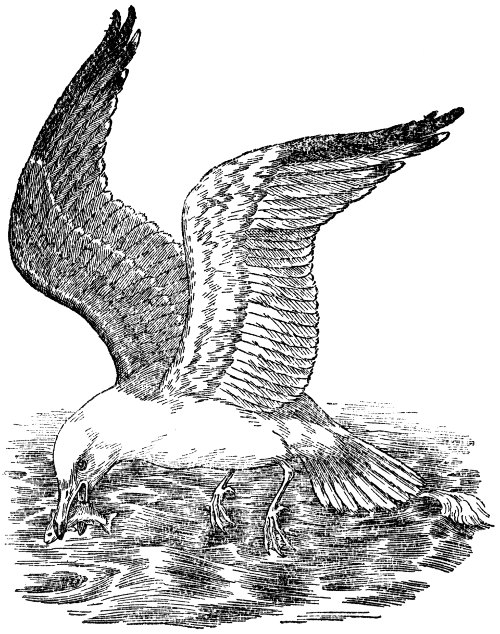
Gull feeding.
“Oh, no, Frank, the gull is by no means dainty about his food. Nor does he live all the year round at the sea. Great flocks of gulls fly inland in spring and autumn. Then they live on worms, grubs, and whatever else can be picked up in the fields.
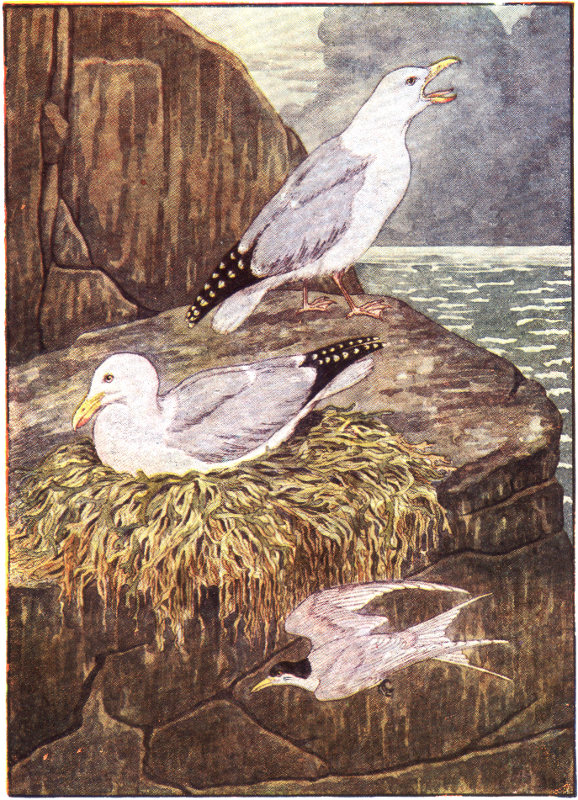
SEA-GULLS AND TERN
“We have a fine chance now, boys, of watching the gull. See, there are some walking on the sand quite close to us, some are floating idly on the sea, some are flying all round us. They think, no doubt, we have lots of bread for them. Now then, boys, tell me about the common gull.”
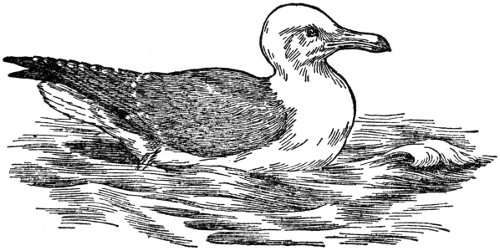
Gull at rest on the water.
“He is a large bird,” said Tom. “His body is white in colour, all but his wings and back. These are of a pale bluish-grey.”
“Very good, Tom,” said Uncle George. “Come on, Frank.”
“He has a large, greyish-green bill. The tip of it is hooked in shape, and yellow. His 66 legs are greenish-grey. The three front toes of his feet are webbed.”
“But,” said Tom, “I can see other gulls darker in colour. Their bodies are dark brown and grey above and light brown below. What are they?”
“They are the young gulls, Tom. They have not got rid of their nest feathers yet.”
“Where do they build their nests?” Dolly asked.
“High up on the cliffs, and on lonely rocky islands. Like the rooks, they all nest together. The gull’s nest is a very simple thing. It is just a hole scraped in the ground and covered with dried grass. Here two, or perhaps three, spotted eggs are laid. The gull is very fond of her young. She will not allow them to try to fly from the high cliff. She carries them one by one on her back down to the sea, and there teaches them to swim.
“Some gulls—the black-headed gull, for example—go far inland to nest. These build their nests on the shores of small hill lakes. They return to the sea with their young ones in autumn.
“Gulls are clever birds. They are bold 67 and active. The wild ocean is their home. Storms bring no fears for them.”
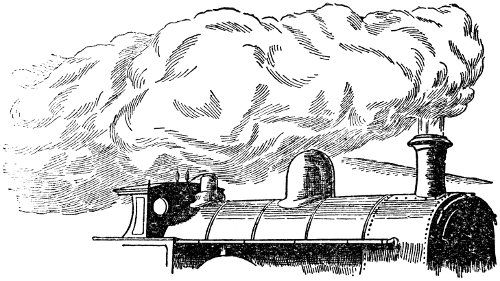
Engine puffing on a cold day.
“How is it, Uncle George, that there is always a clear space between the spout of the kettle and the puff of steam?”
It was Frank that asked the question. He had been watching the kettle boiling for a long time.
“It is the same with the railway engine,” said Tom. “There is always a big space between the funnel and the puff.”
“That is so,” said Uncle George. “But if you watch carefully, you will notice that the space between the funnel of the engine and 69 the puff of steam is not always of the same size.”
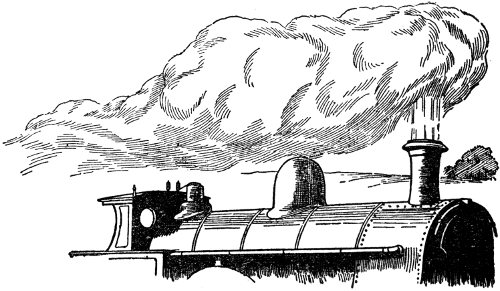
Engine puffing on a hot day.
“No,” said Frank, “I have noticed that the white puff is farther away from the funnel on a hot day than on a cold day.”
“That is true,” said his uncle. “Perhaps you have also noticed that, as the engine rushes along, it leaves a long white cloud trailing in the air behind it. Sooner or later this long white cloud melts away from sight. It melts away sooner on a hot day than on a cold day. Where does it go?”
“It goes into the air,” said Frank; “just as the cloud from this kettle goes into the air of the room.”
“Very good,” said Uncle George. “Tom, will you please fetch me a tumbler full of cold water, and see that the outside of the glass is quite dry?”
When Tom came back with the glass of cold water, Uncle George wiped it outside with a clean dry cloth. When he was sure that the outside of it was dry, he placed the tumbler of water on the table in the middle of the warm room.
“Now,” he said, “let us try to answer Frank’s question about the clear space between the spout of the kettle and the puff of steam.
“The fact is,” Uncle George went on, “the white puff which we call steam is not steam at all. We might just as well call it ‘water-dust.’ For it is made up of tiny droplets of water—so tiny that they float in air. Steam is water in the form of gas. Like the air we breathe, it cannot be seen. In fact, this water-gas forms part of the air around us. The clear space between the spout of the kettle and the puff is made 71 up of hot steam. We cannot see it. As it comes out into the colder air, it is cooled into the tiny droplets which form the puff. It is only when cooled into tiny droplets that we can see it.
“If you hold any cold object, such as a knife, in the puff, these water particles run together and form large drops upon it. The cloud of water-dust melts away in the room, as Frank told us. What takes place is this. The tiny droplets, when spread out into the warm air, become real steam, or ‘water-gas,’ again.
“The outside of this tumbler of cold water was quite dry when I placed it on the table. Run your finger along it and tell me what you find.”
Frank did so, and said, “Why, it is quite wet now.”
“Yes,” said Uncle George, “it is covered all over with very small drops of water. Where did this water come from. It could not come through the glass.”
“It is like dew,” said Tom.
“It is dew—real dew,” said Uncle George. “The water in the glass is much colder than the air around it. The film of air next the 72 glass is cooled, and the ‘water-gas’ which this film of air contains is changed into water drops.
“The earth is heated during the day by the sun, and the layer of air next to it becomes filled with water-gas. At night the earth gets cold. The water-gas, if the night is calm, comes out of the film of air next to the earth. It settles in the form of tiny drops on everything around.
“When the earth gets very cold, the water freezes as it changes from gas to water, and instead of dew we have frost.”
“Oh, that is why we have frost on the inside of the window panes in winter,” said Frank.
“That is so,” said his uncle. “The frost on your window pane is the water-gas of the warm room changed into particles of ice. But let us come back to our steam puff. We spoke about the long white streak of water-dust which the engine leaves behind it. Do you know of anything else like that outside?”
“Oh yes,” said Tom, “the clouds far up in the sky are very like it.”
“They are,” said Uncle George. “In fact, the clouds in the sky and the cloud behind the engine are just the same kind of thing. They are both made up of tiny particles of water.
“We have learnt that the streak of cloud left by the steam-engine melts away quickly on a hot day, also that the puff is farther from the funnel on a hot day. This shows us that the warmer the air is, the more water can it take up and hold. We have also learnt that warm air is light and rises up.[2]
“What happens when warm air, which holds much water-gas, rises up to the higher and colder parts of the sky?”
“It gets cooled,” answered Frank.
“Yes, and its water-gas gets cooled too. Then we can see it as great masses of water-dust. These masses we call clouds. If these masses of cloud get further cooled, the tiny water particles run together to form great drops—as they did on the cold knife. They are now too large and heavy to float in the air, so they fall to the earth as rain.”
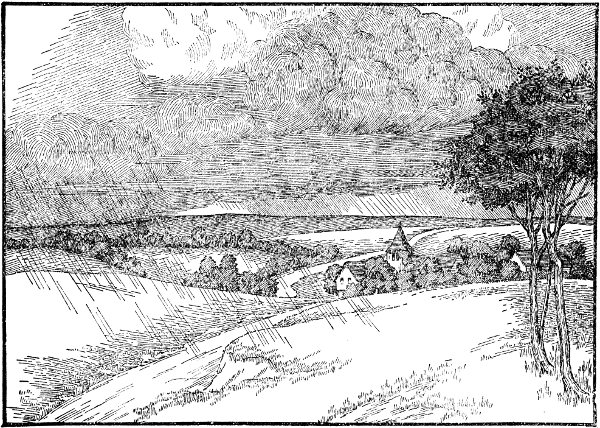
A Showery Day.
PRINTED IN GREAT BRITAIN AT THE PRESS OF THE PUBLISHERS.